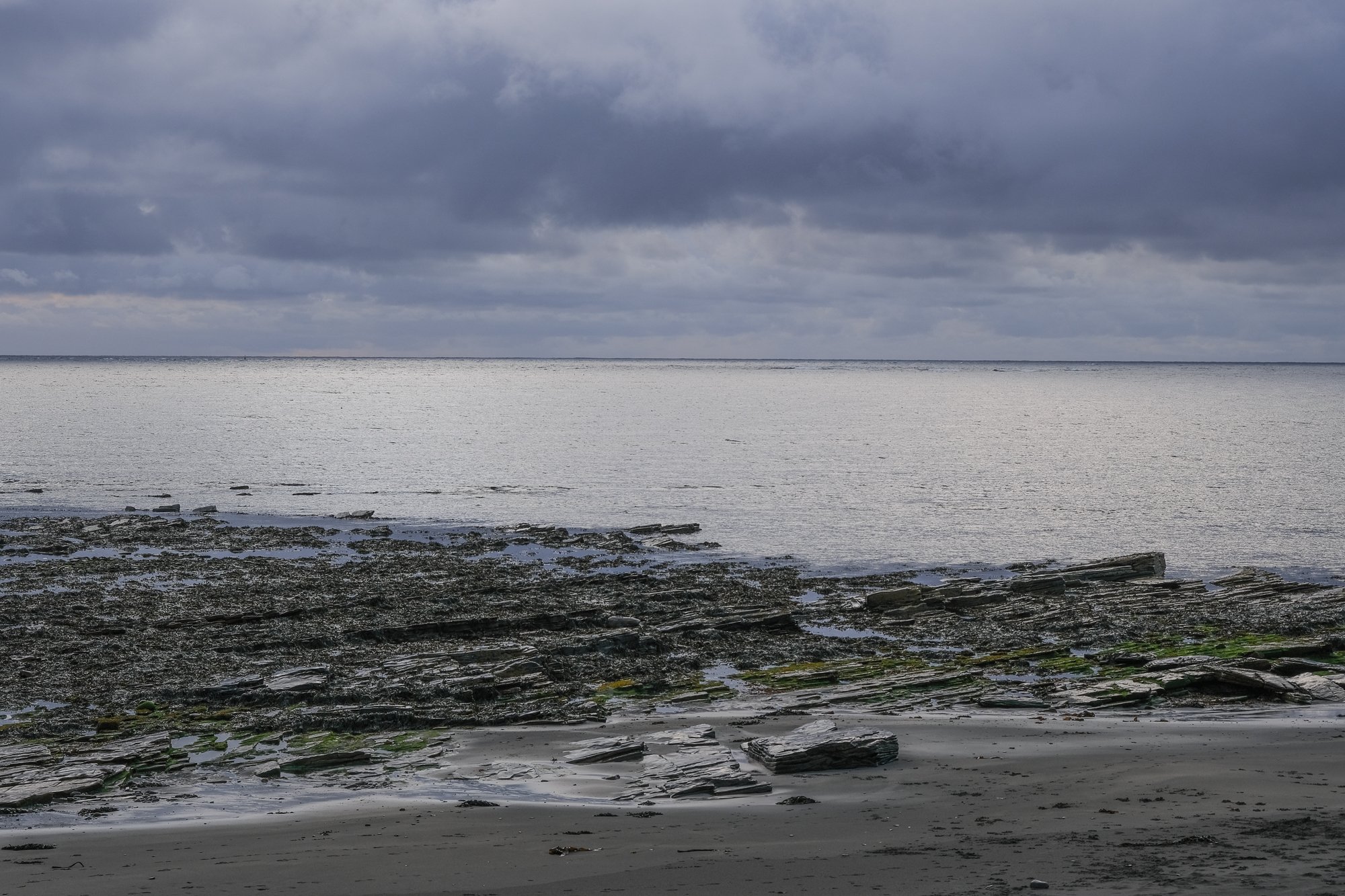In a layered landscape of sea cliffs, sand and shore, farmland, crofts, stone walls and ancient monuments, light calls the shots and colour follows the contours.
The photographer Gunnie Moberg titled her first book about the Orkney Islands ‘Stone Built’ and so they are, each island landscape determined by its underlying rock and coastal profile. From the gentle rolling farmland of Mainland Orkney and low-lying, wind-swept Sanday to the high moorland of Hoy with its towering cliffs and sea stacks, the islands align themselves thinly between a vast sky and an expansive sea. Surprisingly, some of the highest cliffs in Britain are at St John’s Head (346m) on Hoy and their layered form can be seen from the ferry in all their colourful sandstone glory.
Perhaps the most extraordinary feature of Orkney is the quality of the light; be that soft light through layered cloud illuminating green fields and white sands or harsh sunlight intensifying shadows and colours in the physical layers of stone and lichens. Then there are the blue and golden hours either side of sunrise and sunset, beloved of photographers, which flood the landscape with cool or warm colours. On this evening in the sound of Hoy, the blue hour highlights the tidal race and the angled rocks on shore evoking a feel of storm and shipwreck. Next morning, as the blue hour gives way to sunrise, a stillness on the water and the sharp reflection of Hoy High Lighthouse assures us that all is set fine and calm for the day ahead.
The bedrock of Orkney is mainly flat layers of ‘Old Red Sandstone’ and Caithness flagstone, the latter comprising siltstone and mudstone of various thicknesses. Both can be seen on the rocky shores at Warbeth and Nethertown just outside Stromness, where ribs of rock stretch out towards Hoy.
Similarly, the cliffs at Yesnaby are composed of thin layers in which fossilised remains of plants and fishes can be found; even ripples in the sand and mud of what was once an ancient sea bed are set in stone. Here also stromolites, known as ‘Horse-tooth stone’, are being gradually exposed between the layers of flagstone and eroded from surfaces where black coastal lichens are already growing. Stromolites are fossilised mounds of blue-green algae which can still be found growing in parts of the world today. Early in the Earth’s history they were one of several systems using photosynthesis to make glucose as an energy source, releasing oxygen into a hitherto toxic atmosphere and making it possible for life to survive on this planet.
The Caithness flagstone lends itself well to the building projects of humans, and on these virtually treeless islands, it has been used for thousands of years to build walls, dwellings, stone monuments, churches and gravestones. Flagstone was often used as roofing material, as on the croft at West Aith where the film maker and poet Margaret Tait stayed while filming Orkney life in the 1970’s. Now disused, a plaque to her rests in the window among layers of dust, cobwebs and shadows. Wherever there is stone, be that beside the sea at St Mary’s Church or rising from the fields, as does the dovecot at Rendell, there are lichens growing and patterning the surfaces, surviving the rigours of the island climate.
More recent constructions have necessitated the use of other materials, as in the many wind turbines scattered around Orkney. Concrete is often used when once it would have been stone, as in the making of the Churchill Barriers, which were constructed of huge concrete blocks cast on site. The barriers prevented enemy access to Scapa Flow in WW2 and the roads that ran along them linked the islands in the southern part of the archipelago, easing travel and communications for the Orcadians. Today they have become part of the landscape, quite literally in the case of Barrier 4 where layers of sand have built-up and, stabilised by marram grass, have completely covered the blocks on the east side, forming a beach beyond. Lichens also grow on concrete, slowly softening the edges of the blocks and breaking up the surfaces with colour. Looking back from the viewpoint on Burray reveals how the barriers link a patchwork of farmlands over slivers of sea.
There is plenty of livestock farming on Orkney but in September the most obvious signs of activity are the harvesting of crops and the bales awaiting collection in fields that run down to the sea. The shadows of the bales grow longer as the golden hour approaches. Warm light bathes the standing stones at the Ring of Brodgar before gradually fading away to layers of evening blue as the sun sets again over Hoy.































